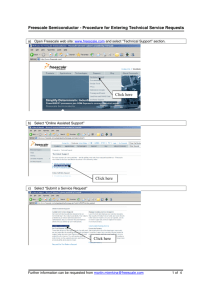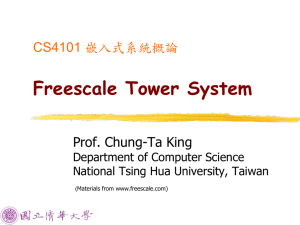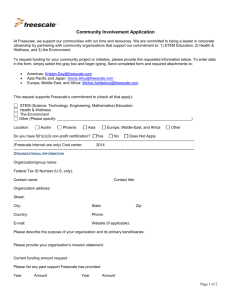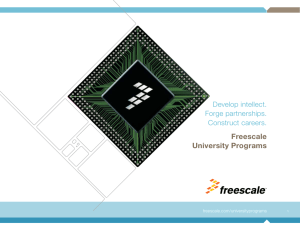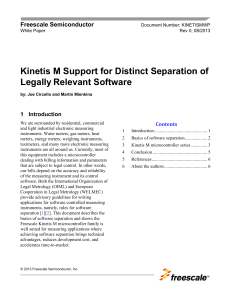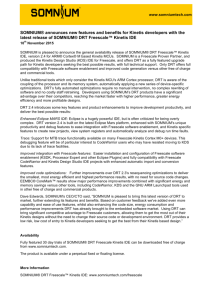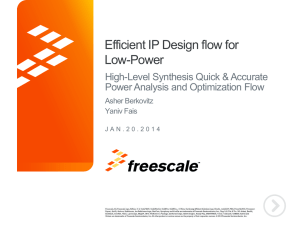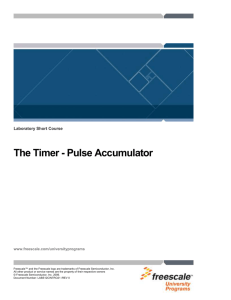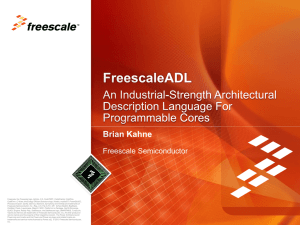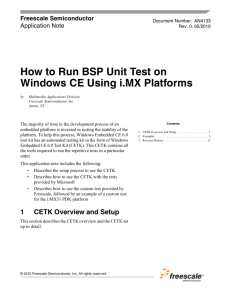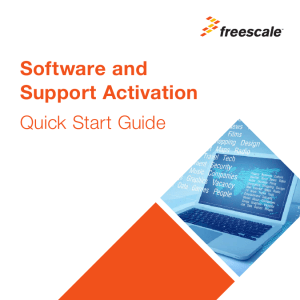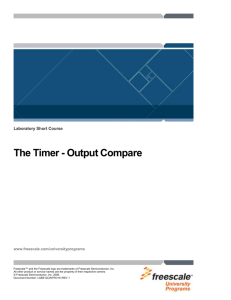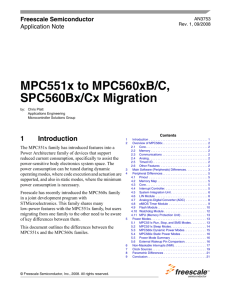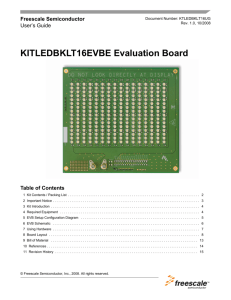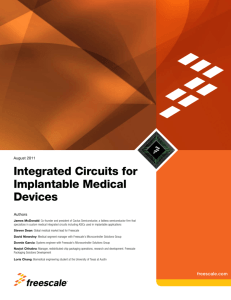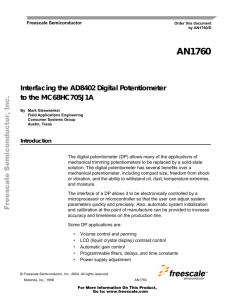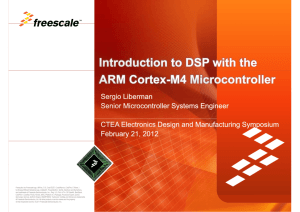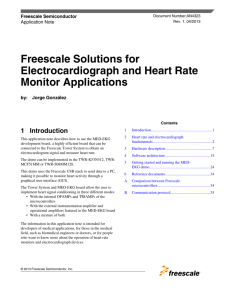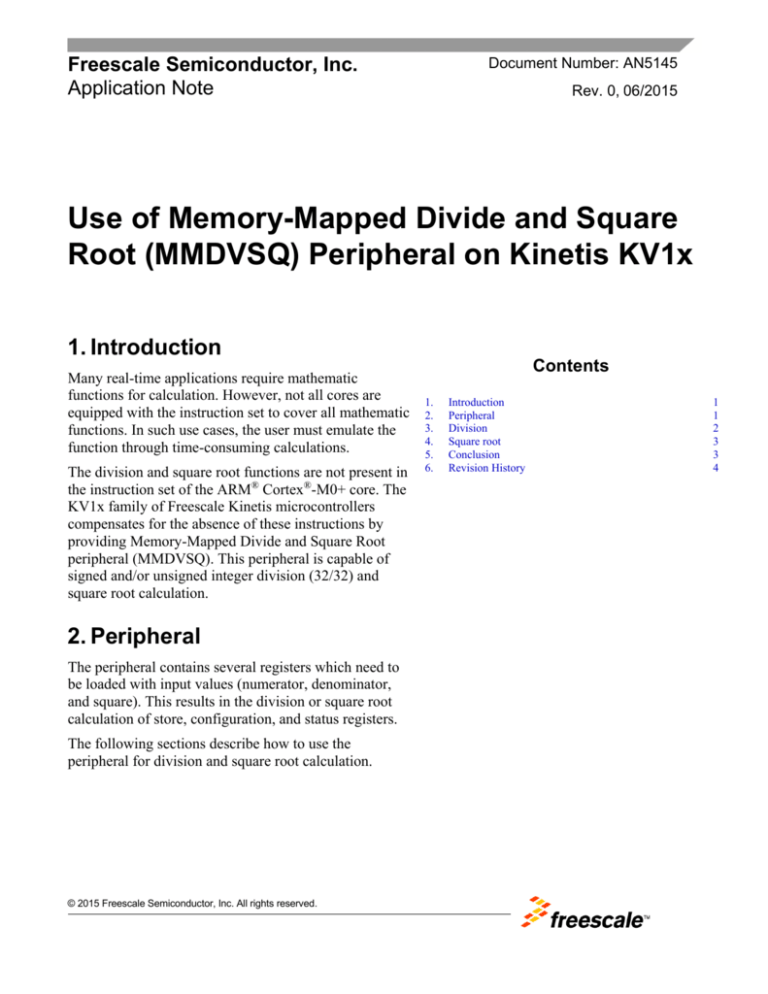
Freescale Semiconductor, Inc.
Application Note
Document Number: AN5145
Rev. 0, 06/2015
Use of Memory-Mapped Divide and Square
Root (MMDVSQ) Peripheral on Kinetis KV1x
1. Introduction
Many real-time applications require mathematic
functions for calculation. However, not all cores are
equipped with the instruction set to cover all mathematic
functions. In such use cases, the user must emulate the
function through time-consuming calculations.
The division and square root functions are not present in
the instruction set of the ARM® Cortex®-M0+ core. The
KV1x family of Freescale Kinetis microcontrollers
compensates for the absence of these instructions by
providing Memory-Mapped Divide and Square Root
peripheral (MMDVSQ). This peripheral is capable of
signed and/or unsigned integer division (32/32) and
square root calculation.
2. Peripheral
The peripheral contains several registers which need to
be loaded with input values (numerator, denominator,
and square). This results in the division or square root
calculation of store, configuration, and status registers.
The following sections describe how to use the
peripheral for division and square root calculation.
© 2015 Freescale Semiconductor, Inc. All rights reserved.
Contents
1.
2.
3.
4.
5.
6.
Introduction
Peripheral
Division
Square root
Conclusion
Revision History
1
1
2
3
3
4
Division
3. Division
The MMDVSQ_CSR register must be configured. There are several bits that control the mechanism:
DFS – Disable Fast Start: this bit controls whether the division starts immediately (cleared) after
the divisor is stored or starts manually (set) by setting the SRT bit.
DZE – Divide-by-Zero-Enable: this bit controls the behavior of the division by zero. If cleared,
the resulting register content is read after the division by zero. If set, a divide-by-zero signal is
generated at the attempt of the result register reading, after division by zero.
REM – Remainder: this bit controls whether the result after the division is the quotient (cleared)
or the remainder (set).
USGN – Unsigned: this bit sets if the division is signed (cleared) or unsigned (set).
SRT – Start: writing 1 to this bit initiates division.
When the control bits are properly set, the input registers can be filled by the input values:
MMDVSQ_DEN – Dividend Register: this 32-bit register stores the numerator of the division.
MMDVSQ_DSOR – Divisor Register: this 32-bit register stores the denominator of the division.
If the DFS bit of the MMDVSQ_CSR register is not set, writing to this register initiates the
division. Otherwise, division is started by the SRT bit.
When division has been initiated, check certain flags in the MMDVSQ_CSR register to know when the
result is ready:
BUSY – Busy: if set, this flag indicates that a calculation is in progress and it is necessary to
wait.
DIV – Divide: if set, this flag indicates that the performing operation is division.
DZ – Divide-by-Zero: if set, this flag indicates that in the last division, the denominator was
equal to zero.
As soon as the BUSY flag is cleared, the result is ready in the result register FSLESL_MMDVSQ_RES.
An example of a signed division of two numbers in C-language is shown below. The numerator and
denominator are input variables, and the result is the output variable.
MMDVSQ_CSR = 0x00000000;
MMDVSQ_DEND = num;
MMDVSQ_DSOR = denom;
Use of Memory-Mapped Divide and Square Root (MMDVSQ) Peripheral on Kinetis KV1x, Rev. 0, 06/2015
2
Freescale Semiconductor, Inc.
Conclusion
4. Square root
There are no control bits for the square root algorithm, so it is not necessary to write anything to the
MMDVSQ_CSR register.
The square root calculation initiates by writing its radicand into the MMDVSQ_RCND register.
When the calculation has been initiated, certain flags in the MMDVSQ_CSR register should be checked
to know that the result is ready:
BUSY – Busy: if set, this flag indicates that a calculation is in progress and it is necessary to
wait.
SQRT – Square root: if set, this flag indicates that the performing operation is the square root.
As soon as the BUSY flag is cleared, the result is ready in the result register FSLESL_MMDVSQ_RES.
An example of a square root calculation in C-language is shown below. The radicand is the input
variable, and the result is the output variable. This example is shown below.
MMDVSQ_CSR = 0x00000000;
MMDVSQ_RCND = rad;
res = MMDVSQ_RES;
5. Conclusion
This peripheral can save the cycle count for the applications where the division and square root
functions are called.
Wherever the peripheral is used, the MMDVSQ peripheral initiates a calculation and generates an
interrupt. The calculation process, which is running, aborts, and a new one starts. The application will
read an incorrect result because when the application returns from the interrupt, it does not understand
that the calculation was previously interrupted. For such use cases, a software state machine should be
created.
The MMDVSQ peripheral is used by the Freescale Embedded Software Libraries (FSLESL) available
for download on www.freescale.com/fslesl. This library benefits from this peripheral in several
algorithms. These algorithms also take care of the previously mentioned interrupt issue.
Use of Memory-Mapped Divide and Square Root (MMDVSQ) Peripheral on Kinetis KV1x, Rev. 0, 06/2015
Freescale Semiconductor, Inc.
3
Revision History
6. Revision History
This table summarizes revisions to this document.
Table 1.
Revision history
Revision number
Date
Substantive changes
0
06/2015
Initial release
Use of Memory-Mapped Divide and Square Root (MMDVSQ) Peripheral on Kinetis KV1x, Rev. 0, 06/2015
4
Freescale Semiconductor, Inc.
How to Reach Us:
Home Page:
freescale.com
Web Support:
freescale.com/support
Information in this document is provided solely to enable system and software implementers to
use Freescale products. There are no express or implied copyright licenses granted hereunder to
design or fabricate any integrated circuits based on the information in this document.
Freescale reserves the right to make changes without further notice to any products herein.
Freescale makes no warranty, representation, or guarantee regarding the suitability of its
products for any particular purpose, nor does Freescale assume any liability arising out of the
application or use of any product or circuit, and specifically disclaims any and all liability,
including without limitation consequential or incidental damages. “Typical” parameters that may
be provided in Freescale data sheets and/or specifications can and do vary in different
applications, and actual performance may vary over time. All operating parameters, including
“typicals,” must be validated for each customer application by customer's technical experts.
Freescale does not convey any license under its patent rights nor the rights of others. Freescale
sells products pursuant to standard terms and conditions of sale, which can be found at the
following address: freescale.com/SalesTermsandConditions.
Freescale, the Freescale logo, and Kinetis are trademarks of Freescale Semiconductor, Inc., Reg.
U.S. Pat. & Tm. Off. Tower is a trademark of Freescale Semiconductor, Inc. All other product or
service names are the property of their respective owners. ARM, ARM powered logo, and
Cortex are registered trademarks of ARM Limited (or its subsidiaries) in the EU and/or
elsewhere. All rights reserved.
© 2015 Freescale Semiconductor, Inc.
Document Number: AN5145
Rev. 0
06/2015

